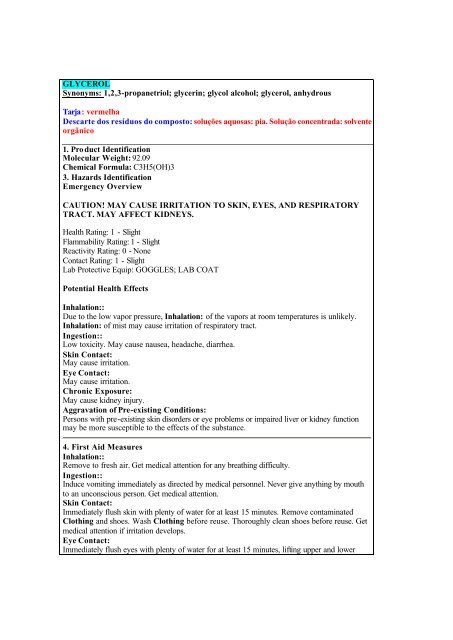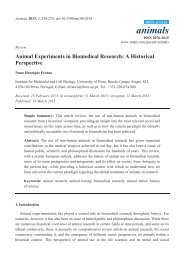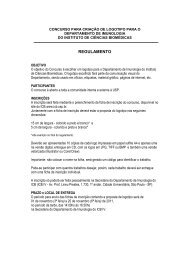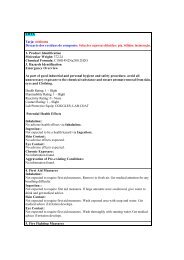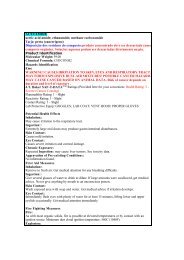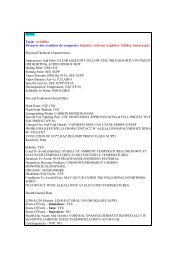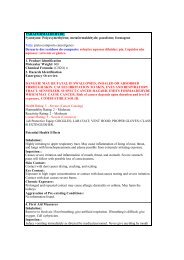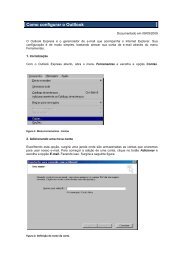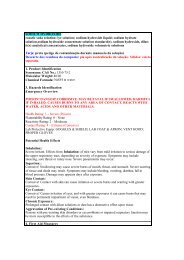GLYCEROL Synonyms: 1,2,3-propanetriol; glycerin; glycol ... - USP
GLYCEROL Synonyms: 1,2,3-propanetriol; glycerin; glycol ... - USP
GLYCEROL Synonyms: 1,2,3-propanetriol; glycerin; glycol ... - USP
You also want an ePaper? Increase the reach of your titles
YUMPU automatically turns print PDFs into web optimized ePapers that Google loves.
<strong>GLYCEROL</strong><br />
<strong>Synonyms</strong>: 1,2,3-<strong>propanetriol</strong>; <strong>glycerin</strong>; <strong>glycol</strong> alcohol; glycerol, anhydrous<br />
Tarja: vermelha<br />
Descarte dos resíduos do composto: soluções aquosas: pia. Solução concentrada: solvente<br />
orgânico<br />
1. Pro duct Identification<br />
Molecular Weight: 92.09<br />
Chemical Formula: C3H5(OH)3<br />
3. Hazards Identification<br />
Emergency Overview<br />
CAUTION! MAY CAUSE IRRITATION TO SKIN, EYES, AND RESPIRATORY<br />
TRACT. MAY AFFECT KIDNEYS.<br />
Health Rating: 1 - Slight<br />
Flammability Rating: 1 - Slight<br />
Reactivity Rating: 0 - None<br />
Contact Rating: 1 - Slight<br />
Lab Protective Equip: GOGGLES; LAB COAT<br />
Potential Health Effects<br />
Inhalation::<br />
Due to the low vapor pressure, Inhalation: of the vapors at room temperatures is unlikely.<br />
Inhalation: of mist may cause irritation of respiratory tract.<br />
Ingestion::<br />
Low toxicity. May cause nausea, headache, diarrhea.<br />
Skin Contact:<br />
May cause irritation.<br />
Eye Contact:<br />
May cause irritation.<br />
Chronic Exposure:<br />
May cause kidney injury.<br />
Aggravation of Pre-existing Conditions:<br />
Persons with pre-existing skin disorders or eye problems or impaired liver or kidney function<br />
may be more susceptible to the effects of the substance.<br />
4. First Aid Measures<br />
Inhalation::<br />
Remove to fresh air. Get medical attention for any breathing difficulty.<br />
Ingestion::<br />
Induce vomiting immediately as directed by medical personnel. Never give anything by mouth<br />
to an unconscious person. Get medical attention.<br />
Skin Contact:<br />
Immediately flush skin with plenty of water for at least 15 minutes. Remove contaminated<br />
Clothing and shoes. Wash Clothing before reuse. Thoroughly clean shoes before reuse. Get<br />
medical attention if irritation develops.<br />
Eye Contact:<br />
Immediately flush eyes with plenty of water for at least 15 minutes, lifting upper and lower
eyelids occasionally. Get medical attention if irritation persists.<br />
5. Fire Fighting Measures<br />
Fire:<br />
Flash point: 199C (390F) CC<br />
Autoignition temperature: 370C (698F)<br />
Slight fire hazard when exposed to heat or flame.<br />
Explosion:<br />
Above flash point, vapor-air mixtures are explosive within flammable limits noted above.<br />
Fire Extinguishing Media:<br />
Use any means suitable for extinguishing surrounding fire. Water spray may be used to<br />
extinguish surrounding fire and cool exposed containers. Water spray will also reduce fume<br />
and irritant gases.<br />
Special Information:<br />
In the event of a fire, wear full protective Clothing and NIOSH-approved self-contained<br />
breathing apparatus with full facepiece operated in the pressure demand or other positive<br />
pressure mode.<br />
6. Accidental Release Measures<br />
Ventilate area of leak or spill. Wear appropriate personal protective equipment as specified in<br />
Section 8. Contain and recover liquid when possible. Collect liquid in an appropriate container<br />
or absorb with an inert material (e. g., vermiculite, dry sand, earth), and place in a chemical<br />
waste container. Do not use combustible materials, such as saw dust. Do not flush to sewer!<br />
7. Handling: and Storage<br />
Keep in a tightly closed container, stored in a cool, dry, ventilated area. Protect against<br />
physical damage. Isolate from incompatible substances. Containers of this material may be<br />
hazardous when empty since they retain product residues (vapors, liquid); observe all<br />
warnings and precautions listed for the product.<br />
8. Exposure Controls/Personal Protection<br />
Airborne Exposure Limits:<br />
For Glycerin Mist:<br />
- OSHA Permissible Exposure Limit (PEL):<br />
Total Dust: 15 mg/m3 (TWA);<br />
Respirable Fraction: 5 mg/m3(TWA).<br />
- ACGIH Threshold Limit Value (TLV):<br />
10 mg/m3<br />
Ventilation System:<br />
A system of local and/or general exhaust is recommended to keep employee exposures below<br />
the Airborne Exposure Limits. Local exhaust ventilation is generally preferred because it can<br />
control the emissions of the contaminant at its source, preventing dispersion of it into the<br />
general work area. Please refer to the ACGIH document, Industrial Ventilation, A Manual of<br />
Recommended Practices, most recent edition, for details.<br />
Personal Respirators (NIOSH Approved):<br />
If the exposure limit is exceeded and engineering controls are not feasible, a half facepiece<br />
particulate respirator (NIOSH type P95 or R95 filters) may be worn for up to ten times the<br />
exposure limit or the maximum use concentration specified by the appropriate regulatory<br />
agency or respirator supplier, whichever is lowest.. A full-face piece particulate respirator<br />
(NIOSH type P100 or R100 filters) may be worn up to 50 times the exposure limit, or the<br />
maximum use concentration specified by the appropriate regulatory agency, or respirator
supplier, whichever is lowest. Please note that N filters are not recommended for this material.<br />
For emergencies or instances where the exposure levels are not known, use a full-facepiece<br />
positive-pressure, air-supplied respirator. WARNING: Air-purifying Respirators do not<br />
protect workers in oxygen-deficient atmospheres.<br />
Skin Protection:<br />
Wear protective gloves and clean body-covering Clothing.<br />
Eye Protection:<br />
Use chemical safety goggles. Maintain eye wash fountain and quick-drench facilities in work<br />
area.<br />
9. Physical and Chemical Properties<br />
Appearance: Clear oily liquid.<br />
Odor: Odorless.<br />
Solubility: Miscible in water.<br />
Specific Gravity: 1.26 @ 20C/4C<br />
pH: (neutral to litmus)<br />
% Volatiles by volume @ 21C (70F): 0<br />
Boiling Point: 290C (554F)<br />
Melting Point: 18C (64F)<br />
Vapor Density (Air=1): 3.17<br />
Vapor Pressure (mm Hg): 0.0025 @ 50C (122F)<br />
10. Stability and Reactivity<br />
Stability:<br />
Stable under ordinary conditions of use and Storage.<br />
Hazardous Decomposition Products:<br />
Toxic gases and vapors may be released if involved in a fire. Glycerin decomposes upon<br />
heating above 290C, forming corrosive gas (acrolein).<br />
Hazardous Polymerization:<br />
Will not occur.<br />
Incompatibilities:<br />
Strong oxidizers. Can react violently with acetic anhydride, calcium oxychloride, chromium<br />
oxides and alkali metal hydrides.<br />
Conditions to Avoid:<br />
Heat, flames, ignition sources and incompatibles.<br />
11. Toxicological Information<br />
Oral rat LD50: 12,600 mg/kg. Investigated as a mutagen, reproductive effector.<br />
12. Ecological Information<br />
Environmental Fate:<br />
When released into the soil, this material is expected to readily biodegrade. When released<br />
into the soil, this material is not expected to evaporate significantly. When released into water,<br />
this material is expected to readily biodegrade. This material is not expected to significantly<br />
bioaccumulate. When released into the air, this material may be moderately degraded by<br />
reaction with photochemically produced hydroxyl radicals. When released into the air, this<br />
material may be removed from the atmosphere to a moderate extent by wet deposition.<br />
Environmental Toxicity:<br />
This material is not expected to be toxic to aquatic life


